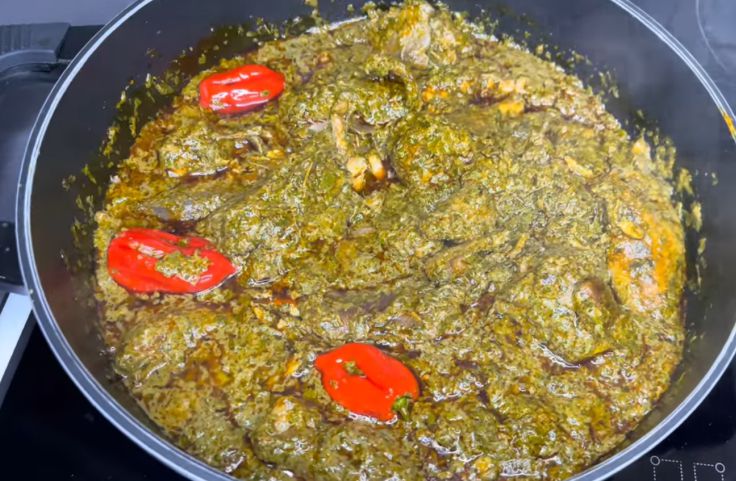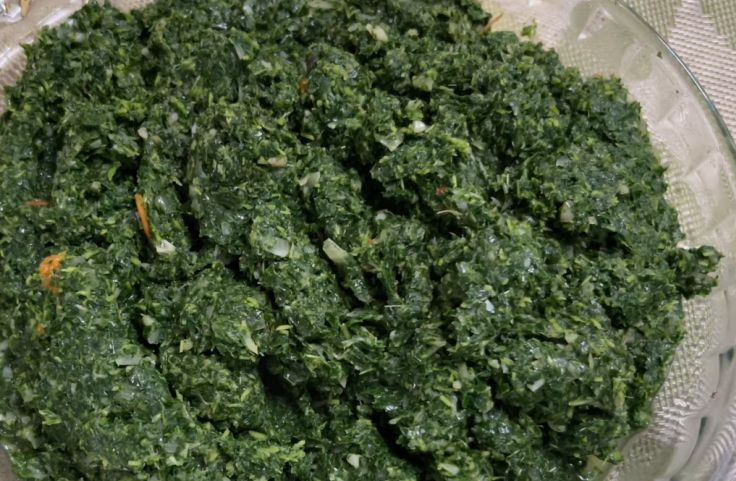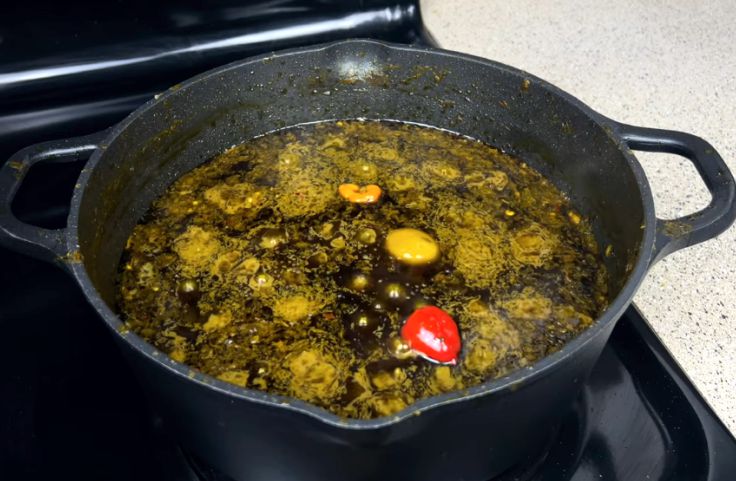Learn how to cook cassava leaves using simple steps and tips. This nutrient-rich dish brings tradition to your table, is safe to prepare, deeply rooted in culture, and satisfying to enjoy.
Cassava leaves are a cherished staple in many African and Southeast Asian cuisines, known not just for their rich cultural importance but also for their nutritional value.
However, cooking cassava leaves requires care and proper technique. These vibrant green leaves contain natural compounds that can be toxic if not prepared correctly.
But don’t worry, when handled the right way, cassava leaves transform into a hearty, wholesome addition to your meals.
You may be aiming for a traditional stew or a simple side dish, but the key steps involve thorough washing, boiling to neutralize toxins, and slow simmering with spices, meats, or coconut milk for added depth.
This guide walks you through each essential step, ensuring your cassava leaf dish is not only safe to eat but also delicious and satisfying.
If you are new to this site, you might like to have a full on the almighty cassava plant here.
Let’s get started in the kitchen.
Table of Contents
- Safety First: Preparing Cassava Leaves for Cooking
- How to Cook Cassava Leaves: Traditional African Method
- Southeast Asian Method: How to Cook Cassava Leaves with Coconut and Garlic
- Basic Recipe: Simple Cassava Leaf Stew
- Cooking Tips and Variations
- Common Mistakes to Avoid
- Frequently Asked Questions
- Conclusion
Safety First: Preparing Cassava Leaves for Cooking
Cooking cassava leaves safely starts with choosing the right ones. Follow these simple steps to prepare them properly and avoid the natural toxins that can cause harm if not handled well.
Choose the Young, Tender Leaves
Pick cassava leaves that are young and soft to touch. These contain fewer harmful compounds compared to older, tougher leaves.
Avoid mature or yellowing leaves because they tend to carry higher levels of cyanogenic glycosides, which can release cyanide when eaten raw or undercooked.
Always go for fresh, green, and unblemished leaves. If you’re unsure, ask a local market seller or farmer for guidance on the right type.
Wash the Leaves Thoroughly
Before doing anything else, rinse the leaves under clean running water.
Don’t skip this step. It helps remove dirt, tiny bugs, or chemical residues.
You can also soak them in a bowl of water for a few minutes and swish them around.
After washing, drain the leaves in a colander. Clean leaves make a big difference not only for safety but also for taste and texture.
Related: How to Cook Cassava Leaf Soup
Chop or Pound Before Cooking
Break the leaves down before putting them on the stove. You can use a knife to chop them into small pieces or pound them using a mortar.
This step helps soften the leaves and brings out their flavor.
Smaller pieces cook faster and more evenly. In some cultures, pounding also helps release natural juices, which adds depth to the final dish.
Boil Long Enough to Remove Toxins
Never eat cassava leaves raw. They must be boiled well to break down any leftover toxins.
Boil them in fresh water for at least 20 to 30 minutes. If the water looks dark or foamy, discard it and add fresh water to continue cooking.
This step doesn’t just make the leaves safer, it also improves their taste and tenderness.
You’ll end up with leaves that are both safe and delicious.
Related Posts
- Nutritional Benefits of Cassava Leaves
- Health Benefits of Cassava Leaves
- 17 Benefits of the Cassava Leaves
- How Does Cassava Affect Pregnancy?
- Is Cassava Good for Weight Loss?
- Is Cassava Good for High Blood Pressure?
- Cassava Leaves Recipes in Different Regions
- Fufu and Cassava Leaves Dish
- What is Pondu?
How to Cook Cassava Leaves: Traditional African Method

If you want to make cassava leaves the African way, this method brings out deep, earthy flavors using ingredients that are easy to find and full of cultural history.
Start with Clean, Chopped Leaves
Wash the cassava leaves thoroughly under running water to get rid of dust or dirt.
Then chop them into small pieces using a sharp knife or food processor.
Smaller pieces cook faster and soak up the flavor of your ingredients better.
Taking time to clean and chop the leaves makes a big difference in both taste and safety, especially when working with fresh produce.
Heat Palm Oil and Sauté the Onions
Pour red palm oil into a large cooking pot and place it on medium heat.
Once the oil is hot, add chopped onions and stir until they turn soft and glassy.
This step builds a rich flavor base for your dish. Palm oil also adds a deep color and smooth mouthfeel that’s common in many African recipes using leafy greens.
Add Groundnuts for a Creamy Base
Spoon in ground peanuts or groundnut paste and stir until it blends smoothly with the onions.
This mixture adds a creamy, nutty layer that gives the dish body and richness.
Keep the heat low so it doesn’t burn. The groundnuts not only improve the taste but also add protein, making the dish more filling and nutritious.
Mix in the Chopped Leaves and Season Well
Add your chopped cassava leaves to the pot and stir until they’re fully coated in the oil and nut mix.
Sprinkle in salt and chopped chili pepper to your liking.
The chili adds a gentle heat that balances the creaminess.
Stir everything together slowly, letting the flavors build without rushing the process.
Simmer Low and Slow for Full Flavor
Pour in a small amount of water, just enough to help the leaves soften, and cover the pot.
Let it simmer on low heat for about 30 minutes. Stir now and then to prevent sticking.
The final result should be thick, creamy, and full of nutty and spicy notes.
Serve it with rice, plantains, or fufu for a comforting, home-style meal.
Related: How to Cook Cassava Root
Southeast Asian Method: How to Cook Cassava Leaves with Coconut and Garlic

In Southeast Asia, cassava leaves are turned into comfort food using coconut milk, garlic, and fish sauce.
This simple method brings out soft, rich flavors with very little effort.
Prep the Leaves the Right Way
Start by rinsing the cassava leaves under running water to clean off dust and dirt. Remove any tough stems that may stay chewy even after cooking.
Once cleaned, steam or blanch the leaves for a few minutes until they feel soft to the touch.
Pre-cooking the leaves like this helps reduce bitterness and makes them easier to digest.
Sauté Garlic for a Fragrant Base
In a clean pan, heat a spoonful of oil over medium heat. Add minced garlic and stir it around until you smell its aroma.
This step builds the base flavor and gives your dish a familiar warmth found in many Southeast Asian recipes.
Garlic also balances the slightly bitter taste of cassava leaves and boosts the overall flavor.
Add the Leaves and Stir Gently
Once the garlic is ready, add your pre-steamed cassava leaves to the pan.
Stir them gently so they soak up the garlic oil without breaking apart.
Let them cook for a couple of minutes to warm through and pick up the flavors.
Keep the heat steady and don’t rush; this part sets the tone for the final taste.
Pour in Coconut Milk and Season with Fish Sauce
Now pour in coconut milk and add a dash of fish sauce for seasoning. Stir slowly to combine everything.
Let it simmer for 10 to 15 minutes on low heat. The coconut milk adds creaminess, while fish sauce gives it a salty, umami kick.
You’ll end up with a smooth, flavorful dish that pairs well with rice or grilled fish.
Let It Simmer and Taste as You Go
Keep an eye on the pot and stir now and then so the milk doesn’t stick to the bottom.
Taste the sauce halfway through, and add more fish sauce or a bit of water if needed.
The goal is a soft texture and a creamy, slightly salty flavor. It should taste both rich and light, with just enough bitterness to remind you it’s cassava.
Related: Cassava Leaf Stew: Everything to Know
Basic Recipe: Simple Cassava Leaf Stew
This easy cassava leaf stew brings you deep flavor and nutrients with minimal effort. All you need is a handful of fresh ingredients and a little patience at the stove.
Gather and Prep Your Ingredients
You’ll need about 500 grams of cassava leaves, fresh or frozen, which works fine. Chop one large onion and mince two garlic cloves.
Measure out two tablespoons of palm oil and set aside some salt.
You can also add smoked fish, chicken, or a few spices if you want a richer flavor.
Keep it simple, or build it up to suit your taste.
Wash the Leaves and Heat Your Pot
Rinse the cassava leaves thoroughly to remove dirt or grit.
If you’re using frozen leaves, thaw and rinse them just as well. In a large pot, heat the palm oil over medium heat.
Add your chopped onion and garlic. Stir and cook for a few minutes until they soften and fill your kitchen with a warm, inviting smell.
Cook the Leaves with Onion and Garlic
Add the cassava leaves to the pot. Stir well so they absorb the palm oil and the flavor of the sautéed onion and garlic.
Pour in 1 to 2 cups of water based on how thick you want the stew. If you’re adding meat or fish, now is the time.
The leaves will slowly break down and soak in the flavor of whatever you’ve added.
Let It Simmer and Season to Taste
Bring the stew to a gentle simmer. Keep the heat low and stir now and then to stop it from sticking.
Add salt to taste. You can also throw in pepper or a spice blend if you like some heat.
Let it cook for 20 to 30 minutes, or until the cassava leaves feel soft and the broth tastes rich and balanced.
Serve It Hot with a Side You Love
When the stew is ready, spoon it over rice, scoop it up with fufu, or serve it alongside boiled plantains.
These sides pair well and turn the dish into a full meal.
You get leafy greens, flavor, and a filling base all in one. It’s comfort food that’s good for your body, too.
Related: Rice and Cassava Leaves Combo
Cooking Tips and Variations
Mastering cassava leaves starts with getting the texture right and bringing out their full flavor.
A few key techniques can make a big difference in how they taste and feel in your dish.
Blanch First for Softer Leaves
Cassava leaves are naturally tough, but blanching them first helps. Briefly boil the leaves in salted water, then drop them into ice water.
This softens them and locks in their green color. It also helps reduce bitterness and makes the final cooking time more efficient.
If you’re after a smooth, flavorful stew, this extra step is worth the effort.
Use Smoked or Fermented Ingredients
If you want bold flavor, toss in some smoked fish or fermented condiments like locust bean or fermented shrimp.
These ingredients bring a deep, savory punch that pairs well with the earthiness of cassava leaves.
You don’t need much to make an impact. A spoonful here and there adds complexity without overpowering the rest of the dish.
Simmer Long Enough to Break Down Toughness
Don’t rush the cooking. Let the leaves simmer for 30 to 45 minutes on medium heat.
This gives them time to soften and blend with the other ingredients.
Stir occasionally and taste as you go to get the flavor just right.
Long simmering also breaks down any leftover toxins that might be present in raw leaves.
Cool and Freeze for Later
Cassava leaves freeze well once cooked. Let the stew cool, then store it in an airtight container or freezer bag.
Push out as much air as you can before sealing. You’ll have a ready-to-go meal whenever you want it.
Just thaw and reheat on the stove for the best texture and flavor. This works great if you like prepping meals in advance.
Common Mistakes to Avoid
Even experienced cooks can misstep when preparing cassava leaves. Knowing what to watch out for can save your dish, and your health.
Undercooking the Leaves
Cassava leaves contain natural toxins that must be neutralized through proper cooking. Skimping on time can leave harmful compounds intact.
Always cook the leaves for at least 30 to 60 minutes.
This not only makes them safe to eat but also unlocks their full flavor and nutritional value.
Don’t rush this part, slow cooking is essential for both taste and safety. Using Mature Leaves
Older cassava leaves tend to be fibrous and bitter. If you want a pleasant taste and tender texture, go for young, fresh leaves.
They cook faster, absorb flavor more easily, and result in a more enjoyable dish overall.
Selecting the right leaves at the start saves you from battling bitterness later on.
Skipping the Chop or Pound
Throwing whole cassava leaves into the pot is a mistake. These leaves have tough fibers that need breaking down.
Chop them finely or pound them before cooking to improve texture and help the seasonings penetrate.
Well-prepped leaves cook more evenly and absorb more flavor, making your stew smoother and tastier.
Leaving Out Aromatics
Neglecting aromatics like garlic, onion, ginger, or chili is a fast track to a bland dish.
These ingredients bring depth and balance to the natural earthiness of cassava leaves.
A simple mix of sautéed aromatics can turn a basic pot into something truly flavorful. Don’t skip this step; it’s the foundation of a well-seasoned meal.
Frequently Asked Questions
Are cassava leaves safe to eat?
Yes, cassava leaves are safe to eat when properly boiled. Cooking breaks down harmful compounds, making the leaves both safe and highly nutritious to consume.
What do cassava leaves taste like?
Cassava leaves have an earthy, spinach-like flavor. Their taste deepens when simmered with palm oil, groundnuts, coconut milk, or spices, depending on the regional recipe.
Can I use frozen cassava leaves?
Yes, frozen cassava leaves work well. Thaw and rinse thoroughly before cooking. They’re a convenient option and retain much of the original flavor and nutrients.
How do I reduce the bitterness in cassava leaves?
To reduce bitterness, blanch the leaves in boiling water before cooking. Steaming also helps, especially when followed by slow simmering with flavorful ingredients.
Conclusion
Learning how to cook cassava leaves might not be a flex, but it sure puts you on the right path of healthy nutrition.
Cooking cassava leaves is more than just a meal, it’s a connection to heritage, wellness, and comfort.
With the right steps, these vibrant greens become a nourishing centerpiece in any kitchen.
From African stews with palm oil and groundnuts to Southeast Asian versions with coconut milk and garlic, each method brings its own charm.
The keys are proper washing, boiling to neutralize toxins, and low-heat simmering to deepen the flavor.
Whether you’re exploring tradition or simply adding variety to your meals, mastering cassava leaves is both rewarding and delicious.
Try it once, and it just might become a regular favorite.
References

Chimeremeze Emeh is a writer and researcher passionate about Africa’s most transformative root crop—cassava. Through his work at cassavavaluechain.com, he explores the entire cassava industry, from cultivation and processing to its diverse applications in food, health, and industrial use.
He also writes for palmoilpalm.com, where he shares his extensive experience and deep-rooted knowledge of palm oil, covering red palm oil, palm kernel oil, and refined products. His work there reflects his lifelong connection to agriculture and his commitment to promoting sustainable value chains in Africa.
Driven by curiosity and purpose, Chimeremeze aims to shed light on how cassava continues to empower communities, strengthen food systems, and link traditional farming wisdom with modern innovation.

